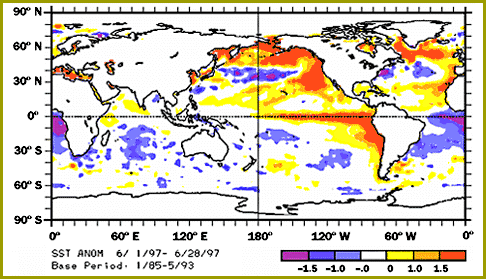
Introduction
Definition
A Brief History
Where does it normally occur and why?
Definition
El Niņo is a climatic fluctuation which causes a disruption of the ocean-atmosphere system, warming the ocean surface. Its event occurs every 2-10 years, and may cause various harm to various parts of the world; for example, alter storm tacks and create unusual weather patterns, affecting the Pacific jet stream winds, and the die-offs of plankton and fish.
A Brief History
The word El Niņo -meaning "the Christ Child" in Spanish- was originally used amongst fishermen along the coasts of Ecuador and Peru to a warm current that typically appeared and lasted for several months every year around Christmas.
During the past 40 years, people began to realise that this event was not just a local Peruvian occurrence but was associated with changes over the entire tropical Pacific and beyond. Most of them raised water temperatures not only along the coast, but also at the Galapagos islands and in a belt stretching 5000 miles across the equatorial Pacific. The weaker events raised sea temperatures only one to two degrees Fahrenheit and had only minor impacts on South American fisheries. But the strong ones, like the El Niņo of 1982-83, left an imprint, not only upon the local weather and marine life, but also on climatic conditions around the globe.
Today, scientists oftentimes refer to this El Niņo phenomenon as the El Niņo Southern Oscillation (ENSO).
The ENSO cycle -lasts for 8 to 10 months.
-entire ENSO cylcle lasts 3 to 7 years, oftentimes including a cold phase known as "La Niņa".
Where does it normally occur and why?

this photograph was taken from http://whyfiles.org/050el_nino/1b.html without permission
El Niņo mostly occurs in the Pacific, however there is no clear explanation and several things could be said about it.
One of the principle differences between the Atlantic and Pacific Oceans are their width of the equatorial region, with the Pacific being more than twice as wide. This area is essential in order to sustain the El Niņo cycle due to the equatorial waves. These waves behave rather differently from other waves, they carry large motion and changes in currents and temperature over a long distance; and may take 3 months to a year to travel from one end to the other side of the ocean. Whereas in the Atlantic Ocean, the waves are able to travel within a month. With the long distances they have covered in the Pacific, these waves may cause one end of the ocean to react to one set of waves and behave differently to the other side of the ocean. As this cycle repeats, an oscillating motion is created; which we commonly refer to as El Niņo/La Niņa.
Another reason why the Pacific is more likely to experience this phenomenon is because the ocean-atmosphere system is driven by "heat" (explained later in "mechanisms")